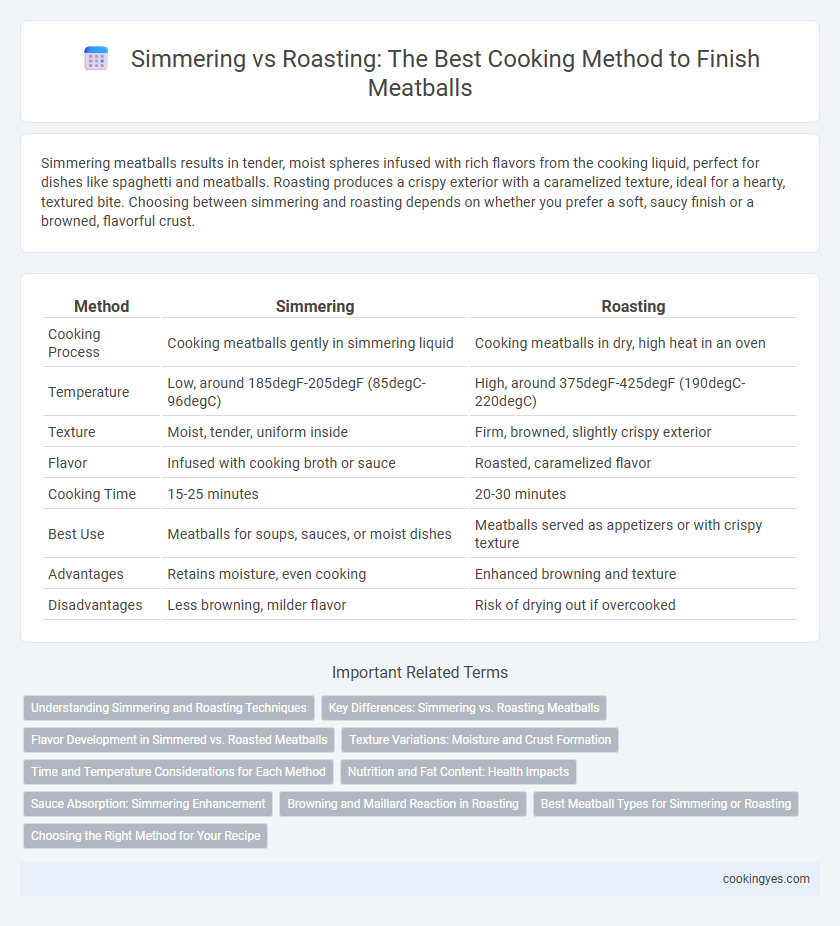Simmering meatballs results in tender, moist spheres infused with rich flavors from the cooking liquid, perfect for dishes like spaghetti and meatballs. Roasting produces a crispy exterior with a caramelized texture, ideal for a hearty, textured bite. Choosing between simmering and roasting depends on whether you prefer a soft, saucy finish or a browned, flavorful crust.
Table of Comparison
| Method | Simmering | Roasting |
|---|---|---|
| Cooking Process | Cooking meatballs gently in simmering liquid | Cooking meatballs in dry, high heat in an oven |
| Temperature | Low, around 185degF-205degF (85degC-96degC) | High, around 375degF-425degF (190degC-220degC) |
| Texture | Moist, tender, uniform inside | Firm, browned, slightly crispy exterior |
| Flavor | Infused with cooking broth or sauce | Roasted, caramelized flavor |
| Cooking Time | 15-25 minutes | 20-30 minutes |
| Best Use | Meatballs for soups, sauces, or moist dishes | Meatballs served as appetizers or with crispy texture |
| Advantages | Retains moisture, even cooking | Enhanced browning and texture |
| Disadvantages | Less browning, milder flavor | Risk of drying out if overcooked |
Understanding Simmering and Roasting Techniques
Simmering meatballs ensures even cooking by gently poaching them in a flavorful liquid, which keeps them moist and tender while infusing them with additional taste. Roasting, on the other hand, uses dry heat for a crispy, browned exterior and a rich, caramelized flavor, enhancing texture and visual appeal. Choosing between simmering and roasting depends on the desired texture, moisture level, and flavor profile of the meatballs.
Key Differences: Simmering vs. Roasting Meatballs
Simmering meatballs cooks them gently in liquid, preserving moisture and infusing flavors deeply, while roasting creates a crispy, caramelized exterior with a rich, browned flavor. Simmered meatballs have a tender, juicy texture ideal for sauces, whereas roasted meatballs develop a firmer, slightly charred crust perfect for standalone dishes. The cooking time and temperature differ significantly; simmering uses low heat over an extended period, and roasting requires high heat for a shorter duration, affecting the overall taste and texture profile.
Flavor Development in Simmered vs. Roasted Meatballs
Simmered meatballs absorb the cooking liquid, resulting in a tender texture and enhanced depth of flavor from herbs, spices, and sauces. Roasted meatballs develop a caramelized crust through the Maillard reaction, intensifying savory notes and adding a crispy exterior. Simmering infuses moisture and complexity, while roasting emphasizes bold, concentrated flavors and a satisfying texture contrast.
Texture Variations: Moisture and Crust Formation
Simmering meatballs in sauce preserves maximum moisture, resulting in a tender, juicy interior with minimal crust development. Roasting meatballs at high heat creates a distinctive browned crust, enhancing texture complexity with a crispy exterior while potentially reducing internal moisture. Choosing between simmering and roasting impacts the balance of softness and crunch, tailored to preferred meatball mouthfeel.
Time and Temperature Considerations for Each Method
Simmering meatballs typically requires maintaining a gentle temperature of 180-190degF (82-88degC) for 20-30 minutes, allowing even cooking and moisture retention. Roasting meatballs is done at a higher temperature, around 400degF (204degC), for 15-20 minutes, resulting in a browned exterior and firmer texture. Time and temperature choices affect juiciness and flavor profile, with simmering offering tenderness and roasting delivering a caramelized crust.
Nutrition and Fat Content: Health Impacts
Simmering meatballs preserves more nutrients by avoiding high temperatures that degrade vitamins, while significantly reducing fat content as some fat leaches into the cooking liquid. Roasting meatballs retains more fat within the meat, resulting in a richer flavor but higher calorie and saturated fat intake, potentially impacting heart health negatively. Choosing simmering supports lower fat consumption and better nutrient retention, aligning with heart-healthy dietary guidelines and weight management goals.
Sauce Absorption: Simmering Enhancement
Simmering meatballs in sauce allows for optimal sauce absorption, enhancing flavor depth through gradual infusion. The low, steady heat promotes tender texture while intensifying the savory profile by melding meat juices with aromatic herbs in the sauce. Roasting, by contrast, creates a browned exterior but limits sauce penetration, offering a different taste experience focused on caramelized crust.
Browning and Maillard Reaction in Roasting
Roasting meatballs promotes intense browning through the Maillard reaction, creating a flavorful crust that enhances taste and texture. This chemical reaction between amino acids and reducing sugars occurs at high temperatures, producing complex flavor compounds and a savory aroma. Simmering lacks this dry heat, resulting in tender meatballs without the characteristic browned exterior that roasting achieves.
Best Meatball Types for Simmering or Roasting
Simmering is ideal for tender, moist meatballs made from lean meats like turkey or chicken, as the gentle heat helps retain juiciness and infuse flavors into the sauce. Roasting suits denser, fattier blends such as beef or pork, allowing for a crispy, caramelized exterior that enhances texture and deepens savory notes. Meatballs combining beef and pork benefit from roasting, while those with seafood or light vegetables thrive when simmered, ensuring optimal taste and consistency.
Choosing the Right Method for Your Recipe
Simmering meatballs in a flavorful sauce enhances tenderness and infuses rich, moist flavors essential for Italian or Swedish recipes. Roasting meatballs creates a crispy exterior and caramelized texture, perfect for dishes that benefit from added crunch and deeper browning, such as meatball subs or appetizers. Selecting the ideal method depends on the desired texture and recipe profile, balancing moisture retention with surface crispness to elevate your meatball dish.
Simmering vs Roasting for meatball finish Infographic

 cookingyes.com
cookingyes.com